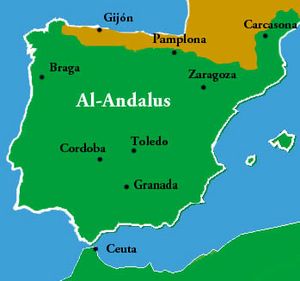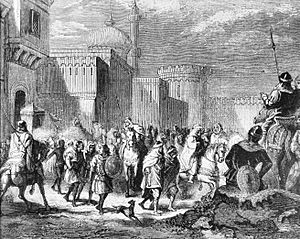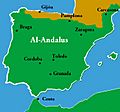Umayyad invasion of Gaul facts for kids
Quick facts for kids Umayyad invasion of Gaul |
|||||||||
|---|---|---|---|---|---|---|---|---|---|
| Part of early Muslim conquests and the Reconquista | |||||||||
|
|||||||||
| Belligerents | |||||||||
| Francia Aquitaine Gascony Lombard Kingdom |
|||||||||
| Commanders and leaders | |||||||||
| Al-Samh ibn Malik al-Khawlani † Abd al-Rahman al-Ghafiqi † Yusuf ibn Abd al-Rahman al-Fihri |
Charles Martel Pepin the Short Childebrand Odo the Great Hunald I Waiofar † Liutprand |
||||||||
The Umayyad invasion of Gaul was a series of military attacks by the Umayyad Caliphate into a region called Gaul. This area is now mostly France. The invasions happened in two main parts, in 719 and 732 AD.
The Umayyads were a powerful Muslim empire. They managed to take control of a region called Septimania. This area was north of the Pyrenees mountains. But their attempts to go further into Gaul, especially into the Loire and Rhône valleys, were not successful.
By the year 759, the Muslim forces had lost Septimania. They were pushed back by the Christian Franks and went back to Iberia (modern-day Spain and Portugal).
This invasion was a continuation of the Umayyad conquest of Hispania. Septimania was the last part of the Visigothic Kingdom that remained. After the city of Narbonne fell in 720, Umayyad armies moved north. These armies were made up of Arabs and Berbers. They advanced towards Aquitaine.
Their advance was stopped at the Battle of Toulouse in 721. However, they still made occasional raids into southern Gaul. These raids reached as far as Avignon, Lyon, and Autun. A major Umayyad attack aimed at Tours was defeated in the famous Battle of Tours in 732.
After 732, the Franks became stronger in Aquitaine and Burgundy. But it took until 759 for them to fully take back Septimania. This happened because the Muslims paid less attention to the area. Also, the local Gothic people were unhappy with Muslim rule.
Later, in the 800s, another Muslim group came into France. They built a fort called Fraxinetum in Provence. This fort lasted for almost 100 years.
Contents
Umayyad Control of Septimania
By 716, the Kingdom of the Visigoths was shrinking fast. It was under pressure from the Umayyad Caliphate in the south. The kingdom was reduced to a province called Narbonensis, also known as Septimania. This area is now roughly the Languedoc-Roussillon region in France.
In 713, the Visigoths in Septimania chose Ardo as their king. He ruled from Narbonne. In 717, the Umayyads, led by al-Hurr ibn Abd al-Rahman al-Thaqafi, crossed the Pyrenees. This was their first scouting trip.
The next campaign to conquer Septimania took three years. Some later Muslim writings say that Musa ibn Nusayr led an expedition to the Rhône river. But these stories are not always accurate.
The next Umayyad governor, al-Samh, crossed the Pyrenees in 719. He conquered Narbonne in that year or 720. Old records say that the people of Narbonne were killed. The fall of Narbonne ended King Ardo's rule. It also marked the end of the Visigothic kingdom.
However, Visigothic nobles still held the cities of Carcassonne and Nîmes. Al-Samh set up military bases in Septimania in 721. He wanted to make it a permanent part of the Muslim territory of al-Andalus.
But the Umayyad advance was stopped for a while at the Battle of Toulouse (721). Al-Samh was killed by Odo of Aquitaine in this big battle. Generally, the Gothic people of Septimania surrendered to the Muslims. They did so under terms that were good for them. This allowed the Umayyads to rule the region with some support from the local people and Gothic nobles.
In 725, al-Samh's successor, Anbasa ibn Suhaym al-Kalbi, attacked Carcassonne. The city had to agree to give up half its land. It also had to pay tribute and become an ally with the Muslim forces. Nîmes and other main cities in Septimania also came under Umayyad control.
During the 720s, there was fierce fighting, killings, and destruction. This especially affected the Ebro valley and Septimania. Many people became refugees. They mostly found safety in southern Aquitaine and Provence.
Around this time, a Berber commander named Uthman ibn Naissa became governor of Cerdanya. This area also included a large part of what is now Catalonia. At that time, Berber soldiers were becoming unhappy with their Arab rulers.
Attacks on Aquitaine and Poitou

Uthman ibn Naissa's Rebellion
By 725, all of Septimania was under Umayyad rule. Uthman ibn Naissa was a Berber lord in the eastern Pyrenees. He broke away from the main Umayyad rule in Cordova in 731. He created his own small state based on Berber power.
This Berber leader made an alliance with Duke Odo of Aquitaine. Odo wanted to make his borders safe. Uthman ibn Naissa is said to have married Odo's daughter, Lampegia. Uthman ibn Naissa then killed Nambaudus, the bishop of Urgell. The bishop was following orders from the Church of Toledo.
The new Umayyad governor in Cordova, Abd al-Rahman al-Ghafiqi, gathered an army. He wanted to punish the Berber commander for going against orders. He surrounded Uthman ibn Naissa and killed him in Cerdanya. This was seen as fair punishment for killing the Gothic bishop.
Umayyad Expedition into Aquitaine
Abd al-Rahman al-Ghafiqi felt strong after his success. He then attacked Duke Odo, Uthman ibn Naissa's ally in Aquitaine. Odo had just faced a strong attack from Charles Martel on Bourges in northern Aquitaine in 731.
Even so, the independent Duke Odo managed to gather enough soldiers. He faced al-Ghafiqi's forces, which had moved north through the western Pyrenees. But Odo could not stop the Arab commander's push towards Bordeaux. The Aquitanian leader was defeated at the Battle of the River Garonne in 732. The Umayyad army then moved north. Their goal was to raid Poitou and plunder the Basilica of Saint-Martin-de-Tours.
Battle of Poitiers (732)
Odo still found a way to save his control over Aquitaine. He warned the rising Frankish commander Charles Martel. Odo told Charles about the danger to the Frankish holy city of Tours.
Umayyad forces were defeated in the Battle of Poitiers in 732. Many people see this battle as the turning point for Muslim expansion in Gaul. Odo died in 735. After putting down an attempt by Duke Hunald to break away, Charles Martel dealt with Burgundy (734, 736) and the Mediterranean south of Gaul (736, 737).
Expansion to Provence and Charles Martel
In 734, Umayyad forces were led by Abd al-Malik ibn Katan al-Fihri. He was the successor to Abd al-Rahman. These forces were called "Saracens" by Europeans at the time. They took control of the cities of Avignon, Arles, and probably Marseille without a fight. These cities were ruled by Count Maurontus.
The leader of Provence had asked the Andalusi forces for help. He wanted to protect his strongholds from Charles Martel's attacks. He might have thought his own soldiers were too weak to fight Charles Martel's strong army. Charles's army was well-organized and made up of soldiers who had been given Church lands.
Charles faced opposition from different groups in the region. The Gothic and Gallo-Roman nobles feared his aggressive policies. Charles decided to make an alliance with the Lombard King Liutprand. He wanted to push back the Umayyads and the local nobles.
Charles also faced hostility from the dukes of Aquitaine. They threatened Charles's army from behind during his military actions. This happened in Septimania and Provence in 737 and 752. The dukes of Aquitaine relied heavily on the strength of their Basque troops. The Basques had been allies with the Aquitanians since the mid-7th century.
In 737, Charles captured Avignon and destroyed it. He also destroyed the Umayyad fleet. However, Charles's brother, Childebrand, failed to capture Narbonne. Charles attacked several other cities that had helped the Umayyads. He destroyed their defenses. These cities included Beziers, Agde, Maguelone, Montpellier, and Nîmes. Before returning to northern Francia, Charles had crushed all opposition in Provence and the Lower Rhone region. Count Maurontus of Marseille fled to the Alps.
Loss of Septimania
Muslims kept control over Septimania for another 15 years. However, in 752, Pepin became the new king. He was Charles's son. Pepin led a new campaign into Septimania. At this time, the local Gothic people were starting to support him.
That year, Pepin conquered Nimes. He then took control of most of Septimania, right up to the gates of Narbonne. In his effort to control the region, Charles faced opposition from the Duke of Aquitaine. Duke Waifer knew about Pepin's plans to expand his power. Waifer attacked Pepin's army from behind with a Basque army during the siege of Narbonne.
In the end, the Frankish king managed to take Narbonne in 759. He promised to respect the Gothic laws. He also gained the loyalty of the Gothic nobles and people. This marked the end of the Muslim presence in southern Gaul. After taking Roussillon, Pepin immediately focused his war efforts against the Duchy of Aquitaine.
Pepin's son, Charlemagne, completed the Frankish goal. He extended the empire's borders beyond Septimania and the Pyrenees. He created a strong barrier state between the Umayyad Emirate and Francia. This buffer zone was called the "Spanish March." It later became important for the Reconquista.
Legacy
Some Arabic words were borrowed into the local languages. For example, tordjman (translator) became drogoman in Provençal. This word is still used in the expression "par le truchement de" (through the means of). Charaha (to discuss) became "charabia" (gibberish).
Some place names also came from Arabic. Or they were named to remember past Muslim presence. Examples include Ramatuelle and Saint-Pierre de l'Almanarre. The latter comes from al-manar, meaning 'the lighthouse'.
See also
 In Spanish: Invasión musulmana de Ifranj para niños
In Spanish: Invasión musulmana de Ifranj para niños
Images for kids




